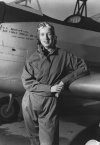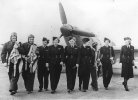dinomartino1
Well-Known Member
WAFS ferry pilots lined up on the airfield during WWII. WAFS (Women’s Auxiliary Ferrying Squadron), along with the WFTD (Women’s Flying Training Detachment) was a predecessor of the WASP program.
Mrs. Nancy Harkness Love, founder of the Women’s Auxiliary Ferrying Squadron (WAFS). The WAFS was created in September 1942 within the Air Transport Command, under Nancy Harkness Love’s leadership. WAFS were recruited from among commercially licensed women pilots with at least 500 hours flying time and a 200-hp rating. Their original mission was to ferry USAAF trainers and light aircraft from the factories, but later they were delivering fighters, bombers and transports as well.
WASP pilot Deanie Parrish in front of P-47 Thunderbolt on the flight line at Tyndall Field, Florida, circa 1943.
Three WASPs on flight line at Laredo AAF, Texas, 22 January 1944.
Attachments
Last edited:


